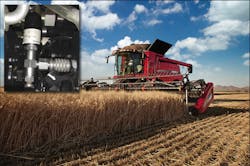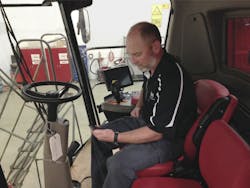Bluetooth Transducer Simplifies Equipment Testing
Whether it’s routine maintenance or troubleshooting a malfunction, pressure testing on agricultural machines and other mobile equipment traditionally has required gauges supplied through hose assemblies or a wired electrical digital pressure transducer connected to the machine’s hydraulic system. That’s because service technicians usually work alone, so without the luxury of a helper, they have to operate the machine from the cab and watch the gauges.
Most testing requires some type of operator control that can only be done from the cab, and sometimes the machine needs to be tested while actually harvesting crops. This means electrical lines or hoses must be strung out and secured away from any rotating belts or chains. After testing has been completed, the connections can be removed from the machine.
That’s the old way. Today’s way uses a wireless pressure transducer that transmits a signal that is read from a mobile device. The operator can then view and record pressure from within the cab even while the machine is working in the field. This convenient and effective method is made possible by the TDWLB Bluetooth pressure transducer from Transducers Direct, Cincinnati. With the TDWLB, a technician simply launches an app on his or her mobile device, selects a transducer, and climbs into the equipment’s cab to begin testing
Rob Matthes, president of Transducers Direct, cites a Case IH 7240 combine as an example. This machine is just over 26-ft long and 15½-ft high. It has two hydraulic systems with nine hydraulic pumps supplying up to 27 different circuits, depending on options. It's roughly 16 ft from the back deck to the cab. The TDWLB is used for hydraulic testing because it is so easy to use, efficient, and accurate.
Whether equipment is tested in a service shop or out harvesting crops, a Bluetooth pressure transducer and mobile device makes testing easy, convenient, and accurate.
Matthes explains, “On this machine, our customer is measuring pressure from 50 to 7,000 psi directly from their seat. Many Case IH independent dealer service technicians have seen the TDWLB product first-hand in technical training sessions. Case IH has compared the TDWLB to many other testing apparatus and finds the TDWLB very accurate and easy to use. Technicians who return to the training sessions after purchasing the TDWLB report positive feedback after using the product on a wide range of equipment.”
The TDWLB comes in nine standard ranges for measuring pressures to 10,000 psi with 1% accuracy, or 0.25% as an option. Standard pressure ports are ¼-18 NPT male, 7/16-20 SAE male, G ¼ male, or 7/16-20 SAE female with 45° flare (optional).
For more information on the TDWLB wireless Bluetooth pressure transducer, call (513) 583-9491, or visit www.transducersdirect.com.


